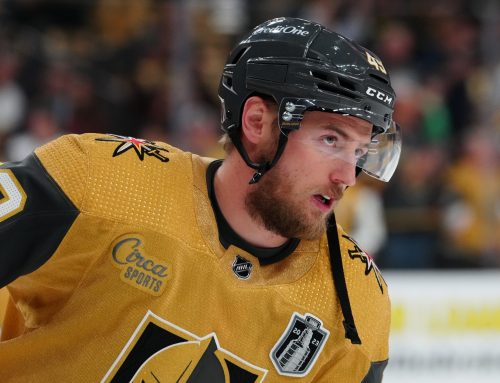This week we return to trade deadline talk. Last week we did a historical walkthrough of the 22-23 season and what happened to the forwards traded. This week we will be touching on defense. We won't be hitting directly on specific trades from 23-24 in this article, but I wanted to set our expectations for what usually happens to players that get moved.
To make this all work I have pulled two Big Board reports from Frozen Tools, one from prior to the deadline and one post-deadline for the 22-23 season. I exported that data and created a custom table with a few of the most interesting categories to me and then filtered by players who changed teams. The deadline action got started early in 22-23 with Bo Horvat moving on January 29th (the deadline itself was March 3rd). Like with the previous article, for the purposes of the table below the "pre" date is actually a date in the middle of February. This means we might get a few games from guys who were moved early in the pre sample, but generally the paces will hold.
In the table below, the first data section contains some basic player information and then the player's 82-game pace. Since we are dealing with different sample sizes I wanted to compare pace numbers. Next, we have the percentage of the team's total power play and total time on ice. These are included to get a general sense of a player's deployment, though certainly doesn't account for things like line mates, or short-handed time. The gray section contains the same categories, but post deadline, and the final section is the change between these two points.
| Name | Pos | Pre GP | Pre 82GP Pace | Pre %PP | Pre TOI | Post GP | Post 82GP Pace | Post %PP | Post TOI | Δ 82GP Pace | Δ %PP | Δ TOI |
| TYSON BARRIE | D | 55 | 54 | 63.4 | 19:18 | 23 | 43 | 60.3 | 21:22 | -11 | -3.1 | 2:04 |
| SHAYNE GOSTISBEHERE | D | 48 | 50 | 61.3 | 22:38 | 22 | 34 | 47.8 | 17:00 | -16 | -13.5 | -5:38 |
| JAKOB CHYCHRUN | D | 36 | 64 | 62.8 | 23:16 | 11 | 37 | 37.4 | 21:09 | -27 | -25.4 | -2:07 |
| JOHN KLINGBERG | D | 46 | 36 | 47 | 20:53 | 17 | 43 | 73.2 | 19:56 | 7 | 26.2 | -0:57 |
| DMITRY ORLOV | D | 40 | 39 | 25.4 | 22:45 | 19 | 39 | 35.6 | 22:32 | 0 | 10.2 | -0:13 |
| RASMUS SANDIN | D | 50 | 30 | 36.2 | 18:00 | 19 | 65 | 56.1 | 22:59 | 35 | 19.9 | 4:59 |
| LUKE SCHENN | D | 54 | 27 | 1.4 | 17:10 | 14 | 6 | 0 | 13:29 | -21 | -1.4 | -3:41 |
| JAKE MCCABE | D | 50 | 28 | 1.4 | 19:28 | 19 | 22 | 2.8 | 19:20 | -6 | 1.4 | -0:58 |
| MATTIAS EKHOLM | D | 51 | 27 | 28.8 | 21:42 | 19 | 56 | 15 | 20:55 | 29 | -13.8 | -0:47 |
| NIKITA ZAITSEV | D | 25 | 13 | 0.1 | 17:13 | 18 | 14 | 1.7 | 15:17 | 1 | 1.6 | -1:56 |
| JACK JOHNSON | D | 53 | 6 | 0.9 | 19:55 | 23 | 14 | 0.4 | 17:28 | 8 | -0.5 | -2:27 |
| VLADISLAV GAVRIKOV | D | 52 | 16 | 10.4 | 22:20 | 19 | 39 | 4.2 | 21:16 | 23 | -6.2 | -1:04 |
In addition to this table, Filip Hronek was also moved, but he only played four games so ultimately his sample wasn't that instructive.
First, let's take a look at the kinds of defensemen moved at the deadline. By-and-large these are depth pieces who likely weren't putting up very relevant point paces, but that certainly isn't universally true. We also see guys like Tyson Barrie, Shayne Gostisbehere, and John Klingberg who are essentially only as valuable as their power-play contributions and a few well-rounded top-four defenseman (Mattias Ekholm, Dmitry Orlov, Jakob Chychrun).
Now let's jump over to the far right 'change' columns and start with the 82-game pace. The results here are relatively mixed. Of the 12 defensemen in the table, six saw a decrease in point pace, leaving six with some amount of increase. Really though only three players saw what we might consider a significant improvement (more than eight points). I am looking here specifically at Vladislav Gavrikov, Mattias Ekholm, and Rasmus Sandin. That means 25% of our D saw a significant increase in point production after being traded. On the surface that seems pretty consistent with our conclusions around forwards. Some odd successes, but for the most part being traded at the deadline doesn't really seem to benefit a player's fantasy output. The news is actually worse than that though. Both Gavrikov and Ekholm moved to a better team for sure but dropped in ice time. They both stayed with those teams in 23-24 and it is now pretty clear that the bump that they saw after the trade deadline in 22-23 wasn't a sustainable one. Both are right on track with their recent career averages. The implication to me is that these are two players who happened to be on the right side of some luck metrics at the same time they changed teams.
Digging in a little bit further, let's move to the ice time stats. In terms of power-play there were only three players who increased their power-play deployment. Klingberg moved to a playoff hopeful in Minnesota who has been struggling with a power-play quarterback all season, and Sandin and Orlov had the benefit of filling in for injured power-play one players right after their trades.
In terms of total ice time Tyson Barrie and Rasmus Sandin were the only players who increased overall time on ice. Barrie moved from an Edmonton team where he was essentially only used on the power-play and Sandin as mentioned above was filling in a top D role on Washington.
So, what are the takeaways here? Well, moving at the deadline is a bad thing for a player's deployment. Only 3 of 12 skaters saw a marked improvement on the power-play and only two saw literally any improvement in overall ice time. When looking at point pace there were only three marked improvements, but looking deeper, of the players who had a fantasy relevant point pace going into the deadline, only one player improved their pace at all (Orlov), and only very marginally. Most of the fantasy relevant point paces dropped fairly dramatically post trade.
So who are the expectations to the rules? First and foremost Rasmus Sandin. He saw a big jump in ice time, both overall and on the power-play. He had been a bit buried in Toronto and moved to a Washington team that was without John Carlson. As such he was able to step into a potent power-play and he thrived. With Carlson back in the picture this year he has dropped back down to a 32-point pace. Similarly, we do also have guys like Klingberg, Barrie, and Orlov who had some opportunity to step into power-play roles with a new team because of injury, or just a general lack of a proficient player, but clearly it is not always a guarantee of an improved point pace.
Our other exceptions include Gavrikov and Ekholm who did increase their point paces, but lost deployment and haven't been able to keep it up this year. To me these don't seem like exceptions as much as wild cards that might show up in any sample split.
For the 23-24 trade deadline season, just like with forwards I think we need to take any hype with a significant grain of salt. These moves are typically not good for fantasy production. The best case can usually hope for is a continuation of whatever they had been doing. The one exception is that if we know they are moving to a situation where they will get top tier deployment (preferably on a decent team a la Sandin). But that is a true statement regardless of whether or not a player is moving teams – any time a player gets a big boost in deployment they are worth our consideration.
That is all for this week.
Do your part to support organizations working to make hockey for everyone.





 EDM
EDM PIT
PIT TOR
TOR VAN
VAN FLA
FLA MIN
MIN DET
DET COL
COL OTT
OTT
